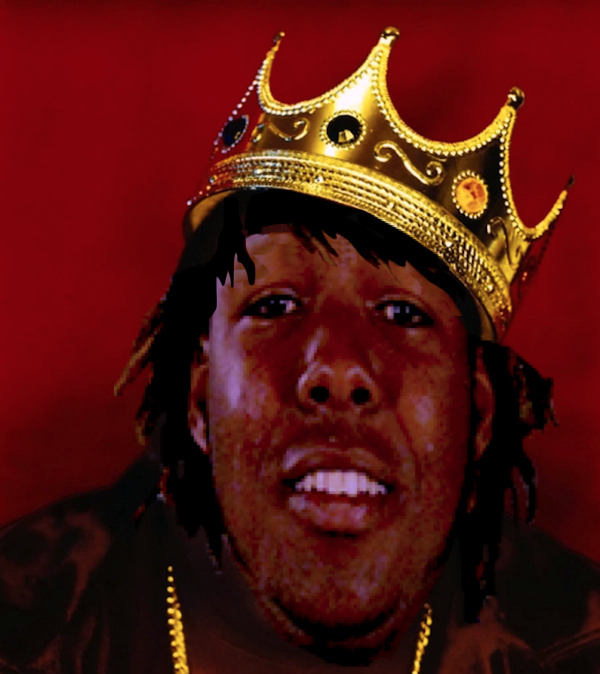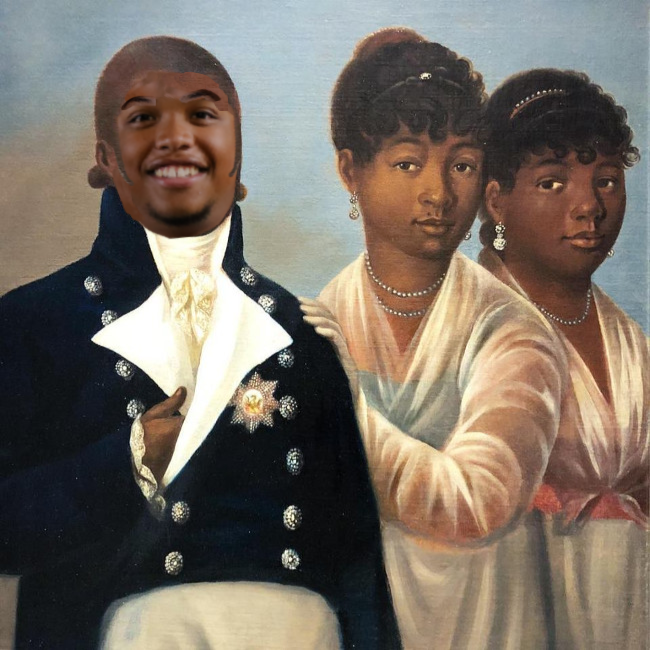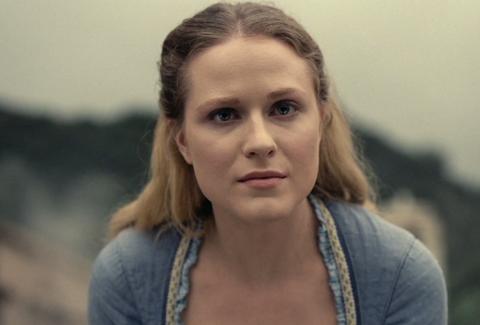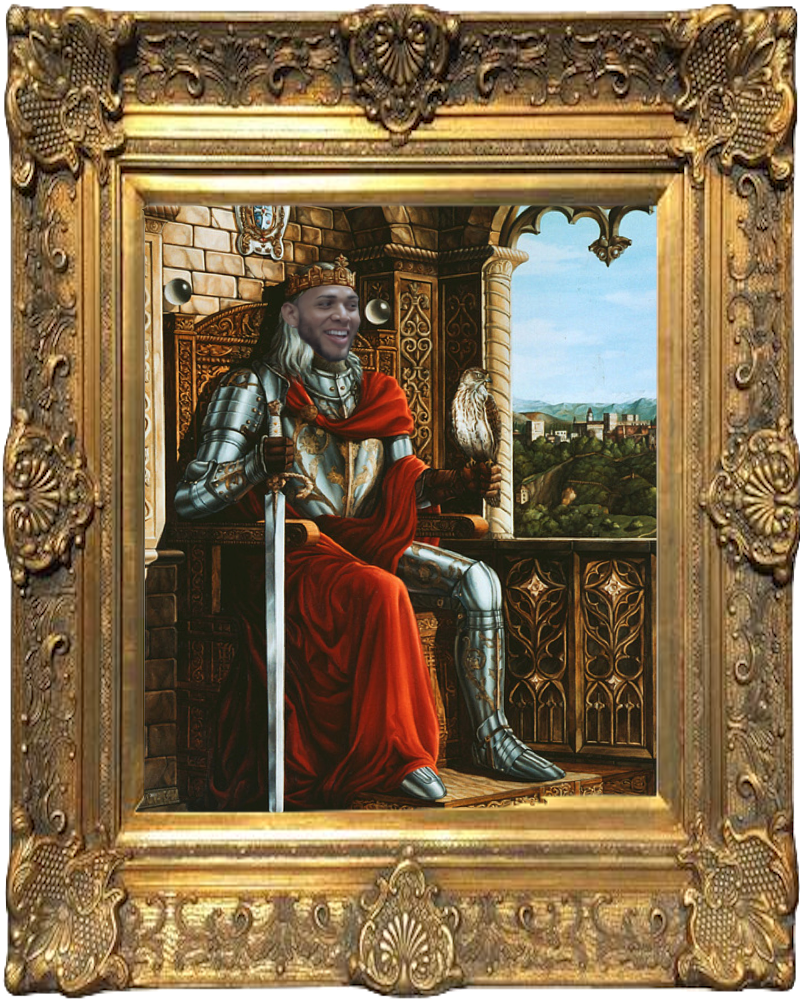Building a Dynasty (Part 2)
Click here if you missed Part 1 or just want to stare into Kris Bryant’s eyes again.
When we left off, I’d just drafted Yoan Moncada in round 2, pick #34 overall. Curious if I was over-aggressive (nuts?) for taking him that early, I glanced at the FantasyPros dynasty ADP. Moncada is #42 overall.
42
I wanted an answer and I got the answer. Not only was it not an egregious pick, it was… destiny.
By round 3, another slew of studs had been ladled from my dreams. J.D. Martinez, Anthony Rendon, Stephen Strasburg, as well as Syndergaard, Gary Sanchez, and of course, Rhys Hoskins. Interestingly, uber-prospect Ronald Acuna went the pick after I selected Moncada.
I understand if you detest my Moncada pick. It’s not the conservative pick. Moncada has a strikeout problem, which could become a fantasy problem. I joke that he has 30-30-30 potential: 30 homers, 30 stolen bases, 30% Strikeout Rate. But Moncada excels at everything else. He hits the ball hard, he has excellent power, he drives the ball to all fields, and he can run like the wind. It’s a truly tantalizing combination of tools, and it’s all from the second base position. “…tools so deafeningly loud it may be a while before we hear the echoes of his historical significance.” At age 22, I couldn’t resist the temptation that if Moncada ‘hits’ as a perennial 1st-rounder, he is mine… forever.
[gfycat data_id=”RegalFreeFlyinglemur”]
When the draft got back to me eight picks later, no player stood out. I didn’t have much of a pre-draft plan – mostly that I’d choose the best player available, try to listen to my gut, and bend toward youth far more than in a typical draft. Yet somehow, at the 47th overall pick, this methodology led me to take another 2nd baseman: annual 35-15 threat Brian Dozier. I don’t love this pick, and in retrospect, I kind of hate it, especially with where the draft eventually led me, which you’ll see in a minute. Don’t get me wrong, I think Brian Dozier is really good – and in this league, which uses OBP instead of batting average, he is technically a 5-category contributor. The last two seasons combined, Dozier has averaged 38 home runs, 96 RBI, 17 steals, 105 runs, and a .349 OBP. As a stat line: .349(OBP)-105-38-96-17. I think he has 2-3 years left of that, hopefully.
Voice of Cynicism: You took two second basemen in your first three picks!? Are you on bath salts!? And why on earth would you draft a 30-year-old who is built like a Lego in a dynasty, when young talents like Marcel Ozuna, Xander Bogaerts, Rafael Devers, and Christian Yelich were available!? I just… don’t understand. When Dozier is 40, Rafael Devers and Ozzie Albies will be 31. Think about that for a second.
Rebuttal to Voice of Cynicism: With 8 hours per pick, I had plenty of time to mull over the choices. Bogaerts was coming off a dreadful (injury-plagued?) season and Yelich had proven to be a solid player but lacked the offensive explosiveness of Dozier. I strongly considered drafting Willson Contreras, whom I believe has rare offensive gifts and was born to hit, but his riskiness pushed me toward the proven vet. I also watched nearly every Twins game down the stretch last season, and Dozier looked amazing. It seemed like he either walked or went yard every at-bat. I once wrote a scouting report of Brian Dozier that began with the following “If I were a scout from Mars looking for Earthly talent, I probably wouldn’t write a glowing review of Brian Dozier.” and ended with “…for the record, the Martian scouts went with Gordon Beckham instead.” But like hoppy beer and Led Zeppelin, Brian Dozier grows on you. He’s an acquired taste. If you saw him walking down the street, you’d probably just think he’s some random dude named Brian. But he can flat out play.
It’s my belief that stars are what win in fantasy. In football, in basketball, in baseball. I’m the kind of guy who loves the 3-for-1 trade where I give up three good players for one transcendent player – or even just a great player – all day long.
Because of that mindset, and because this is a keep forever league, in round 4 I selected my favorite prospect of all prospects, Vladimir Guerrero Jr.

In my years of watching baseball, never have I seen a young hitter possess both such a high floor (all-star) and high ceiling (one of the best players of all-time). This guy is can’t miss, arguably a pure 80 grade in both hit tool and power (personally I’d go 80-70) and I will be completely shocked if he doesn’t become a complete stud at the Major League level. In fact, I value him more than Moncada, but I knew I could wait a bit longer with Vladdy. So, forgetting old man Dozier for a bit, if my three young studs are who I think they are, in three years I’ll have an offensive core of 28-year old Kris Bryant, 25-year old Yoan Moncada, and 21-year old Vladimir Guerrero Jr.
Some guys chase tail. I chase upside.
As much as I love Vladdy Jr., I deliberated over this pick. Simply because it was so early in the draft, and I didn’t want to be overly aggressive. But as Will Smith once said in a movie about black people becoming bankers, “If you want something… go get it!”
I got you, Vladdy.
This Vladdy pick changed the course of my team’s destiny. I’d just devoted two of my first four picks to prospect-aged kids (Moncada and Vlad) and I had to make a decision: am I still trying to compete this year, or am I going all in on the future?
As Sawyer from LOST would say, “it’s all about the looooong con.”
So in round 5, instead of taking a pedestrian 31-year old who will fade out in a couple years … why not draft wild and well-fed Willie Calhoun, who is only 23 years old, and based on my scouting, has a strong chance to be an Anthony Rizzo-like offensive player – a future .300 hitting, 30+ home run masher, who was drafted at pick #87 wedged between the likes of Andrew McCutchen, Orlando Arcia, Rougned Odor, and Avisail Garcia. If Calhoun mashes at an elite level, which I’m confident he will, I just hit a proverbial home run. Sometimes, limited height is a gift. If Calhoun were taller and less beefy, he’d be salivated over like the Eloy’s and Gleyber’s of the world… but he is all mine, several rounds later. Glorious.
Retrospective Interjection (Writer’s Note): This pick makes me a bit queasy. At the time, I was knee-deep in scouting and had become enamored with Calhoun. He was coming off a monster power season with a Rendonian BB:K ratio, and I was convinced that his 5’8 stature was the only thing preventing him from being a consensus top-10 prospect. It was also assumed that Calhoun would spend most of the year in Arlington. As it turns out, Willie is down in the PCL with a discouraging .711 OPS and three home runs through 30 games. Word to the wise: even if you become enamored with a players skill set, exercise caution when targeting them aggressively. While I’m still keeping the faith in Calhoun, it’s absolutely gut-wrenching to see that Gleyber Torres and Ozzie Albies were drafted within the next 20 picks.
To be fair, I avoided Albies because he was one of my most widely owned players – which is one of the strange parts of playing in multiple leagues (avoiding players due to redundancy). I’ve been high on Albies since I saw him in the minors last year, describing him this offseason as, “A personal favorite of mine. Fairly unique skill set; at times, a glimmer of Altuve. Tremendous confidence. Mint grade bat-to-ball skills.”
With Calhoun, I swung for the fences based on a hunch that I was seeing true greatness where others weren’t, and now it appears I was only seeing greatness because of all the Peruvian beet slug extract that I’d procured off the Silk Road. Totally kidding – I’m more of a powdered seahorse-brain man, myself.

Despite the Calhoun pick looking foolish thus far, the pick cemented the idea that this dynasty draft is not about ADP or following any kind of trend. It’s about my own scouting ability. Over the course of scouting prospects – a tedious (yet enjoyable) combination of video, statistics, and scouting reports – I’ve come to realize that playing dynasty is the closest emulation to being a real-life GM. All at once, you take on the role of team owner, GM, head coach, scout, and rabid fan. Video games like MLB The Show and O.O.T.P.B. offer more immersion in terms of setting ticket prices and negotiating salaries, but the results of dynasty baseball are connected to real results on the field, rather than a simulation, and that makes it the most immersive GM emulation available. Almost immediately, I was hooked.
When I say “scouting”, I don’t just mean “video highlights” on MiLB.com. I’ve scoured Youtube for obscure cellphone videos from 2004 of Brent Rooker playing whiffleball in his yard, players performing in high school, college, overseas, and in Nick Pratto’s case: The Little League World Series. Spoiler Alert: I reached hard for Pratto. He isn’t in many top-100 lists, but he’s in my personal top-30. It’s hard to get overly excited about a 1B prospect, but I think the bat is that special. The phonetic similarity between Nick Pratto and Joey Votto is a not-so-subtle hint from the Baseball Gods. Votto is a bit bigger – taller and thicker – but their swings and approach are eerily similar.
As the draft rolled on (twenty teams / eight hours per pick), I seemed to adopt an instinctive strategy that valued the following traits:
- talent
- youth
- not a pitcher
You know the cliche about pitching prospects. I adhered to that cliche for the most part – although I am absolutely gaga for Brent Honeywell, who was scooped up just ahead of me at pick 6.2. I settled for Brendan Rodgers five picks later. Honeywell’s injury that followed was unfortunate, but long-term I still view him (in a best-case scenario) as a glorious tribrid of Greg Maddux, Dan Haren, and Roy Halladay. While roughly 95% of scouts prefer the flame-throwing, Syndergaard-esque physicality of Michael Kopech, I like Honeywell’s long-term prospects a bit more. He possesses:
- excellent stuff (94+ mph heat with terrific movement, and an array of devastating off-speed pitches)
- elite pitchability (yes, that’s an official term now. It’s the pitching version of “hit tool”.)
- An unmistakable confidence and swagger that often crosses the line into arrogance.
- Tampa Bay’s track record of making the most out of young pitchers
Sign me up.
But I suppose Brendan Rodgers will do. At Coors, we are looking at a future .280-30-90 shortstop – questionable plate discipline balanced out by his superb power and raw hitting ability. Trevor Story, if he were less like Trevor Story, and more like Nomar Garciaparra. Make no mistake, folks – Brendan Rodgers is going to be a star. The only question is when.
Six rounds and 120 picks into the draft, many of my top pitching targets were still available, which suggests that other teams abide by that cliche, too. It’s been interesting to see the approach of other teams (other virtual GM’s). My prospect-oriented team is the clear anomaly in the draft room. Most of the teams strive for a combination of ‘win-now’ and prospects, while a few teams have gone entirely ‘win-now’. One other team has a clear youth-only focus, but he is targeting a generation above mine, drafting players like Benintendi, Polanco, Conforto, and Bogaerts – and not a single player from a generation higher.
In round 7 I was happy to land Astros prospect Kyle Tucker, a high upside left-handed hitter who I view as a combination of Cody Bellinger and Buster Posey. His mechanical, unconventional swing takes some getting used to, and initially, I had ‘Nam-style flashbacks to prospect phenom Matt Wieters, but the more I watch Tucker, the more I like him. And that funky swing started to appear super controlled and dare I say… smooth. In a way. Like good scotch. Appreciating Kyle Tucker is like staring into one of those hidden images that initially appear to be a random splatter of splotches and dots.
It doesn’t look like anything to me.
But then you see it – err, him. A future .275, 30 homer, 15 steal beast that will soon make a freakishly stacked lineup even more fearsome. In round 7, in a rapidly declining talent pool that saw Giolito, Chris Taylor, and Jonathan Villar fly off the board, I am happy – no, ecstatic – to land Kyle Tucker. And the gobs of prospective trade suitors that came calling on him post-draft, have only further cemented the fact that this future fantasy superstar is not going anywhere.
Parting Thoughts
In the end, I’m betting on my ability to scout talent. I’m betting on myself. I’m betting that in a few years, my team won’t just be strong, but will be almost comically stacked. I’m betting that scouts are wrong about touted guys like Francisco Mejia, and I am right about future Ian Kinsler clone Jahmai Jones, and Joey Votto impersonator Nick Pratto.
It’s possible that I’ve made, as Gob would say, “A terrible mistake” – and that my pivot toward prospects after the Guerrero pick was a monumental blunder.
It’s also possible that I zigged while everyone else zagged, and I will have the last laugh.

Part 3 Coming Soon!

Is this a pay league? Because if it is, you just wasted your entry fee..Somewhere you lost the wisdom of winning the year you signed up and you fell into the “Rebuild Trap”. Logic like Nick Pratto being the next Joey Votto makes me nauseous. Votto is a future hall of fame player who is reaching base at supernatural paces while playing EVERY. SINGLE. GAME. And everyone being the next Anthony Rizzo isn’t much better rationale. While you have told a story in an entertaining fashion, there is so much flawed logic I had to stop reading.
Merit:
My 16 team dynasty league roster
https://ibb.co/cn91b7
https://ibb.co/bFWsin
https://ibb.co/eFJuw7
https://ibb.co/enWEw7
My other 16 team dynasty league roster (first year league):
https://ibb.co/nKznin
https://ibb.co/cNS7in
https://ibb.co/g2ftOn
https://ibb.co/ed9nin
Both were pay to play. Both are highly competitive. Go young but let the prospects do their own things. Win now. Dominate forever.
Hey Trep. I appreciate your honesty. To be frank, if I could do it all over, I’d try to win now. However, the tides (Moncada, Vladdy) took me in a particular direction, and instead of fighting the current, I rode it like a wave.
To see a similar draft methodology in action, check out Tom Trudeau and Greg Wellemeyer’s team in the RTI Dynasty Invitational.
They pulled it off much better than me, and had superior taste with their prospect picks, but our teams are rooted in the same idea: in a league with 20 teams, if all teams/managers are created equal, each team has a 5% chance of winning the title each season.
So how do you make your team stand out from the pack? By buying Apple stock before it becomes Apple stock, if that makes sense. In a league this deep, even the teams that drafted purely to win-now, are lucky to have 3 star players. If you draft a team flush with talented prospects, it creates the somewhat-plausible scenario that in a few years, you will have significantly more talent than any other team. For what it’s worth, in this league, if you win the title one time, it earns you the equivalent of nine years of entry fees. Not sure if that helps or hurts my case… but if my team ultimately becomes a team of stars, and I win a title or two or three, it will earn back the cost of the ‘tank’ years – and then some.
But above all, this is experimental. I went into this dynasty knowing very few prospects. Now I check MiLB.com more than I check MLB.com. While I love watching polished big leaguers at their best, I think I enjoy scouting youngsters, and trying to predict the future, even more.
As for the Votto and Rizzo comps – they are certainly hyperbolic. There is only one Joey Votto. There will only ever BE one Joey Votto. If Nick Pratto ever becomes 70% as good as John Olerud, that will be a massive win. By invoking Votto’s name, I was trying to cast light on why I like Nick Pratto – smooth all-fields approach, elite natural hit tool, solid power potential, discerning eye. I’ll definitely keep that in mind for part 3 though. And it’s something I think all scouts, and aspiring couch scouts, struggle with: when making player comparisons, it’s much easier to remember successful MLB players who are burned into your memory. It’s much more difficult to recall the playing style of Pedro Feliz or Greg Colbrunn. “If this guy pans out, he might be the modern Marvin Benard”.
Anyway, thanks for (partially) reading and thank for your honest thoughts. I completely see where you are coming from.
Great article, was looking forward to part 2 and am now looking forward to part 3!
As for your team, I think you have a great core of Bryant Guerrero Moncada, but man you better hope you’re right with guys like Pratto, Calhoune, Jones etc or you could be in some real trouble! Personally, I would have been targeting the Poloncos and Buxtons of the world in that area of the draft and then try to get some of those deeper prospects later in the draft. You may have reached on some guys in my opinion but like you said, if you’re right then you will have a beast team in a few years. Good luck!
Thanks for reading, Brett.
The thing with guys like Jahmai and Pratto, is they don’t feel like big risks where I took them (can’t same the same for Calhoun. yikes.)
For example, I took Jahmai #274 overall, right after fringe-y pitchers like Blake Parker and Alex Cobb, and right before Jackie Bradley Jr. I took Pratto in round 18, pick 354, which was a round filled with aging “meh” players who will be irrelevant in 2-3 years, if not sooner. I do envy the Jason Groome pick in that round by the Sacramento Rivercats.
I certainly have a lot of pick regrets, mostly in terms of being overly aggressive on “my” guys, if that makes sense- and just being new to the prospect game. I could have written about my other dynasty league, where I snagged Trea Turner, Hoskins, Albies, Devers, Pollock, among others… but it wouldn’t exactly make for a compelling read – no one wants to read about a wealthy young banker who regularly hooks up with models. We want the wholesome love story about the humble, against-the-odds guy who gets the girl of his dreams through sheer courage and heart. And lots of trial-and-error and misadventure along the way.
Regards!
I am a dynasty veteran and I just did my first new dynasty draft in a long time this past year. I went the opposite of you and I think it is the right thing to do. Basically, every prospect and young player is crazy overrated and all the veterans are underrated. I am sure every draft plays out differently, but I built a win-now squad and when everyone else was filling in their roster in the mid rounds, I drafted one of the stronger farm systems. Do the opposite of what everyone else is doing is good advice. Sure, I don’t have Vlad Jr, but I have a bunch of solid specs. It is easy to pretend that young players and specs are going to be awesome, but they will most likely be terrible – even the ones that earn a role will likely end up about 70% of what you drafted them for and they will be young and inconsistent – which is how you lose – trust me, I know from experience! The other factor to consider is value – a prospect that has a down year or eats it in the show has little value whereas an established guy isn’t going to suffer that fate. You can always sell off vets around the deadline for specs, which seems like the proper way to build a farm. Here I am one month in and my league-mates are already talking rebuild and looking at my specs and I am already leading my division.
thanks for the comment, Kraken.
I can see what you mean about prospect value versus veteran value.
I’ve already seen two of my prospects value decrease (McMahon and Kingery). I was receiving generous offers for them during Spring Training, but declined because I was so taken with the hypothetical of what they could become. Now I couldn’t trade McMahon if I included my kidney in the deal.
Another factor I didn’t consider is how quickly – and seemingly out of nowhere – new appealing prospects emerge onto the scene. Guys like Sam McWilliams, Kacy Clemens, Cavan Biggio, Travis MacGregor, and Darrick Hall are hot commodities, whereas a few weeks ago they were barely on the radar (or on my radar anyway).
It’s definitely been an eye-opening experience. I still maintain that this squad is going to be filthy in a few years, but had I simply drafted with a ‘best player available’ mentality, there was the opportunity for a solid win-now core in addition to a decent farm. I’m eager for another opportunity to draft a dynasty team, with a more balanced approach in mind. Unfortunately, it’s difficult to find any dynasty startups after Opening Day. I tried to get this super deep league in motion, but the interest was lukewarm.
Having said all that, I’m still fully committed to building this team (Missoula Osprey) into a powerhouse, and it’s already been rewarding seeing guys like Caleb Smith have success, and guys like Verdugo and Soroka get promoted.
See you around these parts
-Tim
I’ve played in a few super deep (2000+ players owned) leagues and this strategy fails every time someone tries to implement it. At best they draft or trade for a bunch of players who don’t hit the majors at the same time, they trickle in and screw up the window of competition. At worst most of the prospects don’t pan out and the owner is left with nothing. Owner eventually gets tired of trying to find mlb dregs to fill his roster out and quits leaving a mess for the next owner.
I hear you. It’s risky.
But I’m confident in my ability to scout baseball players. My failed redraft teams of the past weren’t failures because I drafted the wrong players, it was because I drafted them too early – a year or two before they fully realized their skills.
This prospect strategy is a patient man’s game. I’m going to be burning money for a few years. I’m paying for brick-layers and laborers, but in the end I will have a castle.